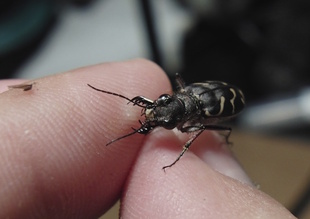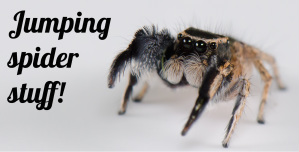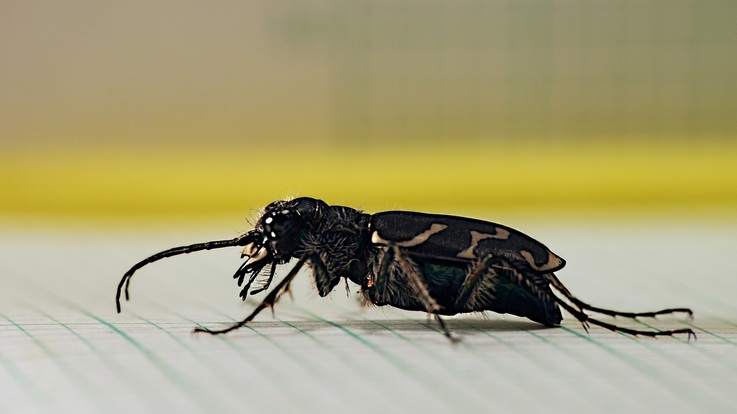
Cornell Chronicle has a good summary of the paper, with an interview with Cole Gilbert.
DB Zurek, MQ Perkins, and C Gilbert (2014). Dynamic visual cues induce jaw opening and closing by tiger beetles during pursuit of prey. Biology Letters, 20140760
| Daniel B. Zurek |
|
 In dynamic locomotory contexts, visual cues often trigger adaptive behaviour by the viewer, yet studies investigating how animals determine impending collisions typically employ either stationary viewers or objects. We described a dynamic situation of visually guided prey pursuit in which both impending prey contact and escape elicit observable adaptive behaviours in the pursuing tiger beetle. We investigated which visual cues may independently control opening and closing of the beetle's jaws during chases of prey dummies. Jaw opening and closing typically occur when prey is within the 60° binocular field, but not at specific distances, angular sizes or time-to-collision. We show that a sign change in the expansion rate of the target image precedes jaw opening (16 ms) and closing (35 ms), signalling to the beetle that it is gaining on the target or that the target is getting away. We discuss the ‘sloppiness' of such variation in the lag of the behavioural response, especially jaw closing, as an adaptation to uncertainty about target position due to degradation of the target image by motion blur from the fast-running beetle. Cornell Chronicle has a good summary of the paper, with an interview with Cole Gilbert. DB Zurek, MQ Perkins, and C Gilbert (2014). Dynamic visual cues induce jaw opening and closing by tiger beetles during pursuit of prey. Biology Letters, 20140760
1 Comment
We're trying out crowdfunding for our next spider catching expedition using Experiment.com. Check out the project page here: http://experiment.com/projects/why-are-some-jumping-spiders-so-colorful? To us, this is as much about funding as it is about communication. The great thing about Experiment.com is that even small donations get people personally invested, and the site enables the researcher to give regular updates and share the fascination that drives scientists. We plan to do a video diary while we're out in the field, and lab notes as we work back on campus. Science communication usually happens when the work is done, when months and years of work are distilled into a publication and, for the lay public, into short news articles. The process of science is a mystery to many people, and often involves images of serious white-coated folks hunched over bubbling beakers in a sterile lab. That applies even to students in the sciences, who all too often get their first real exposure to scientific work in grad school. So aside from enabling us to start an exciting project, we think approach can show people how basic science is done.
We have recently begun to document and characterize dynamic visual signals in Habronattus jumping spiders. These adorable animals are tiny and not easily photographed, and even harder to film. Males react dynamically to the female and will approach and retreat many times during courtship. We are currently testing different camera configurations to image dances at high resolution, one of our first "ultra hd" 4K videos is embedded below. Luckily, in this species the male will stay close to the female once he feels reasonably safe. Lisa Taylor, Nate Morehouse and I are organizing a symposium entitled "Color signals in terrestrial invertebrates: integrating senders and receivers" at ISBE next week. I collected the symposium abstracts here for easy reference, in order of presentation. The full abstract book of ISBE 2014 can be found at http://www.isbe2014.com.
 It's conference season! Cole Gilbert will present our Cornell-based work on retinal movements of freely moving jumping spiders at the Congress of Neuroethology in Sapporo. The title is "An insight into situational gaze movements of jumping spiders". At (almost) the same time, I will give a talk about color vision in jumping spiders at ISBE in New York, opening the color signaling symposium. The title is "Color vision in a colorful predator: light path absorbance and retinal sensitivities in jumping spiders". A 2011 video by Wayne Maddison, showing a brazilian amycine salticid visibly moving its eyes, recently went viral. Last year, said video was the inspiration for Cole and me to get some transparent spiderlings, and formally test their eye movements in a controlled lab setting. It involved placing the spiderlings in a bottom-lit glass arena, where they tracked a small target on a motorized drum that formed the arena wall. Here is an early video with just a paintbrush as stimulus, dead drosophila for size (set resolution to 1080p!): We're still analyzing data, but will present the story later this summer. One of the interesting preliminary results is an asymmetry of how the two principal eyes are tracking targets in contra- and ipsilateral visual hemispheres.
Cornell Chronicle posted a nice video summary of our tiger beetle obstacle negotiation story, along with an interview with Cole Gilbert. Check it out here.
Ed Yong of National Geographic (and Not Exactly Rocket Science) interviewed me last week and just posted a great summary about our obstacle-sensing antenna story. You can find it here.
 Tiger beetles are predatory insects with acute eyesight, which run so fast that they can be blinded by motion blur. They are able to catch up to fleeing prey despite having to stop and re-orient themselves multiple times during the chase. While this works fine in an open lab setting, the question came of obstacle negotiation in the field came up. How do tiger beetles avoid running headlong into path obstructions during their blind sprints? The answer lies in their antennae, which they position so that their tips stay very close to the ground. Unlike many nocturnal animals, which wave their feelers around for wide-field search, tiger beetles keep them rigidly in front. Their flexible tips reliably make contact with pebbles, sticks, and other surface features, and enable the beetle to adjust its body angle before "face planting". This makes it possible to detect and negotiate obstacles at high speed without even seeing them. This study can be found in Proceedings of the Royal Society B: Biological Sciences, 281 (1779). Together with Lisa Anne Taylor (U Florida) and Nate Morehouse (U Pittsburgh), I am currently co-organizing a symposium entitled "Color signals in terrestrial invertebrates: integrating senders and receivers" for the 2014 Meeting of the International Society for Behavioral Ecology (ISBE) at Hunter College in New York City. The symposium will take place on August 1st. The aim is to advance an integrated view of the role color plays in animal behavior by bringing together researchers working on both color vision and coloration in terrestrial invertebrates. We hope to showcase recent exciting advances in this area, leading to a more complete understanding of the roles of senders and receivers of color signals, in the context of their visual habitats.
|